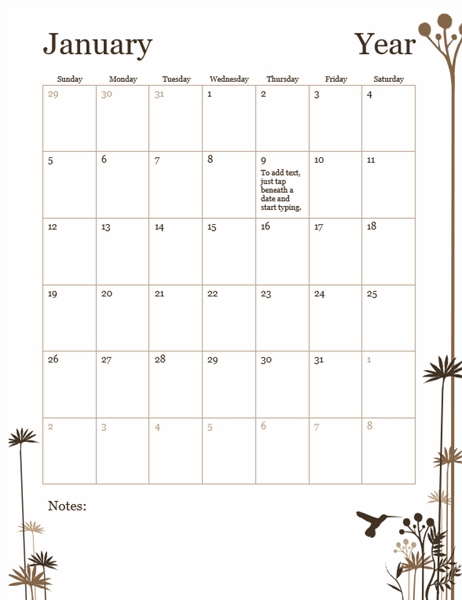

- MICROSOFT WORD TEMPLATES CALENDAR SOFTWARE
- MICROSOFT WORD TEMPLATES CALENDAR DOWNLOAD
- MICROSOFT WORD TEMPLATES CALENDAR MAC
- MICROSOFT WORD TEMPLATES CALENDAR WINDOWS
However, we’ll also want to make some adjustments to the top two rows. The height of the boxes within your table is now set. Note: Depending on your region, Word may use inches instead of centimeters by default. 2.5 cm is a comfortable height, but you can adjust it to fit your preferences. Click the “Row” tab, check the box next to “Specify Height,” and enter the desired height in the text box.
MICROSOFT WORD TEMPLATES CALENDAR SOFTWARE
You are tasked with creating a usable design that others will work with on a daily basis.Ī solid template makes it easy for your internal team or client team to create and work on documents in standard software in a way that represents their brand well.The “Table Properties” window will appear. Conclusionĭesigning a Microsoft Word template might not seem like the most interesting design project. The final option is to save the template document as a read-only file so that when someone tries to open and edit it, the only option is to create a copy and work on it from there. Don’t forget to “Save As” for a new file. Otherwise, go to File > Open and browse for the template name. If the template is stored in the location with all the system default templates, it will be available to use when you create a new document.
MICROSOFT WORD TEMPLATES CALENDAR DOWNLOAD
Whether you create or download a template from a third-party source, the last step is to add the template to Word so that it is usable on that computer.
MICROSOFT WORD TEMPLATES CALENDAR MAC
Mac Template File Location: /Users/username/Library/Group Containers/UBF8T346G9.Office/User Content/Templates. 
MICROSOFT WORD TEMPLATES CALENDAR WINDOWS
Windows Template File Location: My Documents/Custom Office Templates. The best practice would be to save your template files in common system default areas so they are easy to find later. While there are standard locations for template files on Windows and Mac devices, you can save a template file anywhere you like. If you save and finish and want to continue to make adjustments later, you can do so by opening the template, making changes, and saving again. The common location for template files is under Custom Office Templates in My Documents, but you can save the template anywhere that makes sense to you. You’ll be prompted to choose a file location for the template. When you are ready to save, you need to select “Save As Template” from the file menu (“Save As,” then select file type “Word Template” on Windows). Design the template using normal design tools, such as font choices, colors, and static elements. You can also set instructions as well to help make the template for user-friendly. Using the Developer tools, set “Rich Text Content Controls” that allow users to insert text or images in certain areas of the template. (It’s not as intimidating as it might appear.) This requires accessing the “Developer” features. Add content controls and customize the main tabs and toolbars. Start with building blocks if you need reusable pieces of content, such as a header or footer. Microsoft has pretty extensive documentation. Note that you can do this on desktop versions of Microsoft Word, but not the web app. When it comes to editing a template and resaving it as a new template, there are a few more steps. When it comes to basic editing, start with an open document. Once you know how Word templates work, you’re ready to edit an existing template or create your own and save it for your team or clients. Edit, save, print, track changes, and more. This is a common practice with company templates such as letterhead, so that the original is not alerted inadvertently.įrom there, you use a Word template just like you would with any other document. If that is the case, you’ll have to use the “Save As” option to save the file and make changes. Note that some Word templates may be set as read-only by your system administrator. There’s no need to insert a template into a Word file because it is already there. The great thing about Word templates is that as soon as you open the file, it is ready to use.






 0 kommentar(er)
0 kommentar(er)
